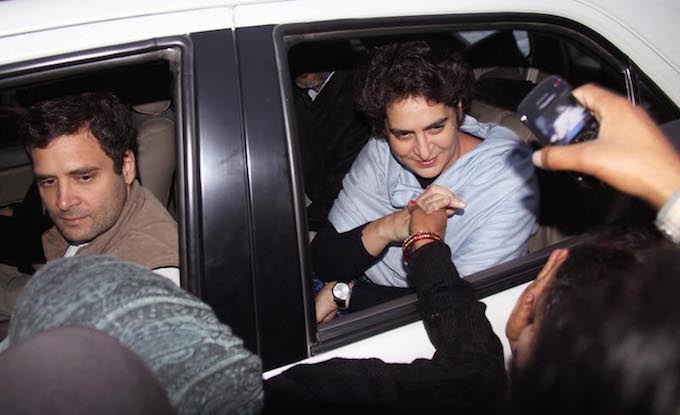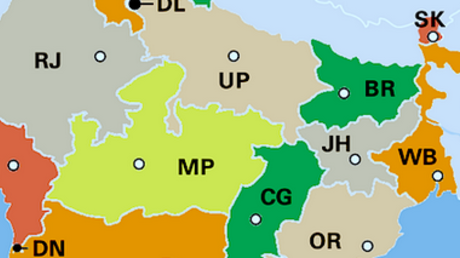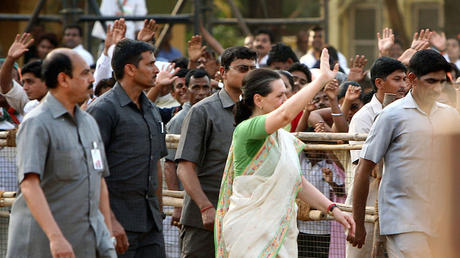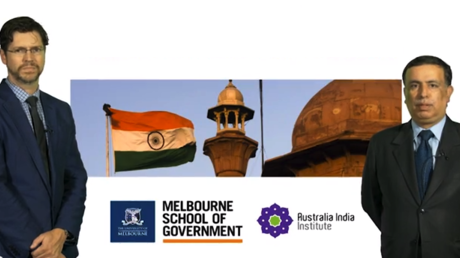
Rahul Gandhi and his sister, Priyanka Vadra, campaigning in the family's seat of Amethi.
As campaigning ended for the eighth and penultimate phase of polling in India’s general election, the focus was on Amethi – the Gandhi family seat.
An impoverished district in eastern Uttar Pradesh, among the poorest in India, Amethi is the parliamentary constituency of Rahul Gandhi, vice-president of the ruling Congress Party. Gandhi has represented Amethi for 10 years. Before him, his mother, father and late uncle have been MPs from Amethi. In 2009, he won by 370,000 votes, indicating the strength of the family’s – and the Congress’ – grip.
On May 5, in the final hours of canvassing, Narendra Modi arrived in Amethi to address the biggest political meeting the BJP has ever managed in the constituency. That the meeting took place at all was telling. It demonstrated Modi’s challenge to the Congress and to the Nehru-Gandhi dynasty.
Criticising Rahul Gandhi and his sister, Priyanka Vadra, who has been campaigning for her brother, as well their political legacy, Modi argued that Amethi and its voters had got little reward for their loyalty to the Congress. Social indices, job creation, infrastructure and education were in a mess. Indeed Amethi was lagging behind many peer districts.
This direct assault on what has hitherto been an impregnable fortress for the Nehru-Gandhi family served two purposes. First, it made Amethi the most watched of the 64 seats – across seven states – voting today (May 7). Second, expectations of a big public meeting and a grand speech ensured television cameras were at the venue, thus giving Modi a national audience at an opportune time, just as campaigning closed.
The shrewd manner in which the BJP’s prime ministerial candidate has used news television as a force multiplier has been one of this election’s innovations. At key moments, he has created a blockbuster media magnet to ensure the cameras are on him and his pictures and words are streaming live to drawing rooms all over India.
Back on April 7, the first day of the five weeks of phased polling now coming to an end, the BJP released its election manifesto. Strictly speaking, this should have happened before that date. On April 24, as other constituencies voted, Modi filed his nomination papers in Varanasi, travelling across the city in a massive show of political mobilisation. Both events got blanket television coverage.
The Amethi public meeting followed the same principle. While located there, speaking to the crowd gathered and attacking Rahul Gandhi’s performance as a constituency MP, Modi had one eye on another region, far, far away: Seemandhra, on the southern coast of India.
In 2009, the state of Andhra Pradesh was instrumental in the Congress winning power. It gave 33 of its 42 seats to the party, and helped the Congress reach a plurality of 206 seats (of 543) in the Lok Sabha (the Lower House of the Indian Parliament).
Earlier this year, Andhra Pradesh was divided into two daughter states: Telangana and Seemandhra. The partition, which will be formalised only on June 1, followed a period of political and social ferment. This was blamed substantially on the Congress-led government in New Delhi.
The 25 parliamentary constituencies and 175 constituencies of the state legislature of Seemandhra vote today. Plainly the Congress is in trouble and the battle is between the YSR Congress, a breakaway party headed by the son of a former Congress chief minister, and an alliance of the Telugu Desam Party and the BJP.
A rich harvest of seats in Seemandhra would be of big help to Modi. That is why, in his Amethi speech, he referred to two late politicians from Andhra Pradesh: T. Anjaiah and former prime minister P.V. Narasimha Rao.
He spoke of how Rahul Gandhi’s father Rajiv had publicly humiliated Anjaiah in the 1980s, in an incident that had left the veteran politician weeping. Next Modi referred to Sonia Gandhi, Rahul’s mother, snubbing Rao even in his death.
In doing this, Modi combined his appeal to Amethi – the most high-profile constituency voting today – with his outreach to Seemandhra, which has the largest bloc of seats up for grabs.
He also re-emphasised what has become an essential verity of this election campaign – in India’s hyper-televised democracy, there is now no such thing as a local speech. All politics is, or can be made, national. All you need to do is attract the television cameras.





